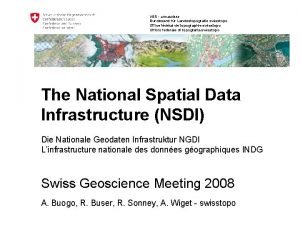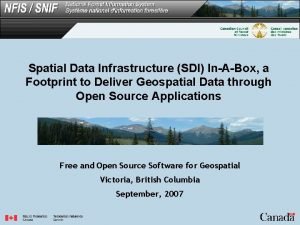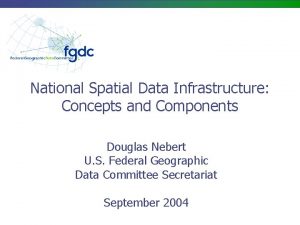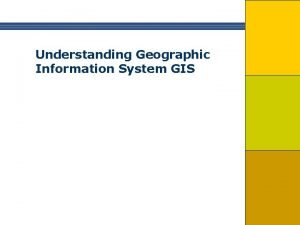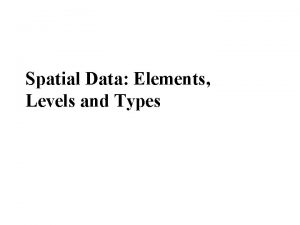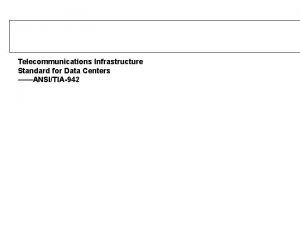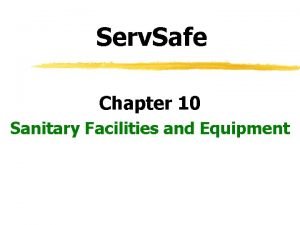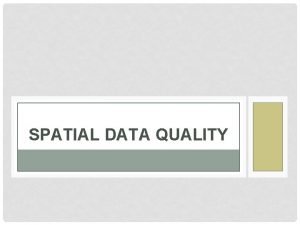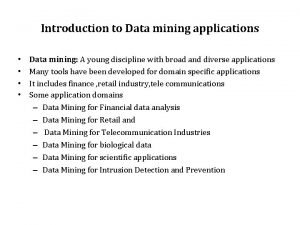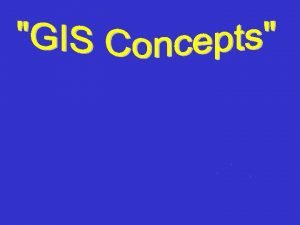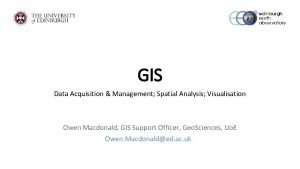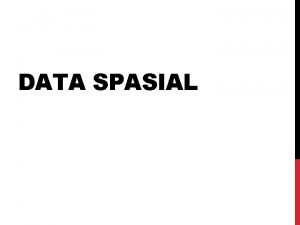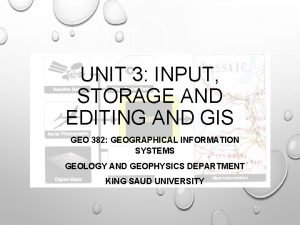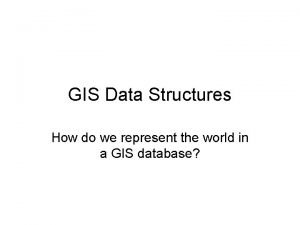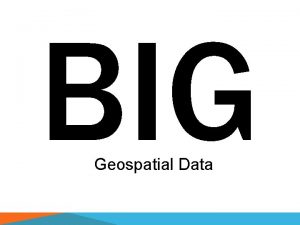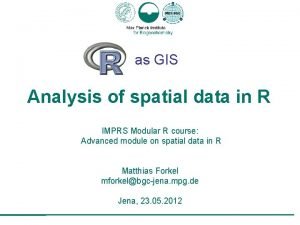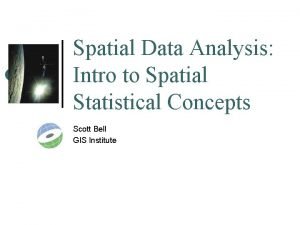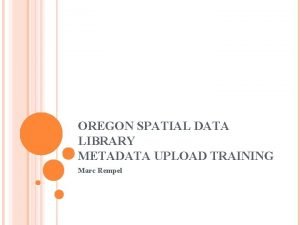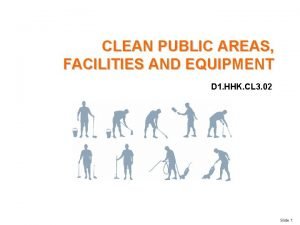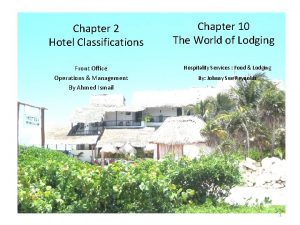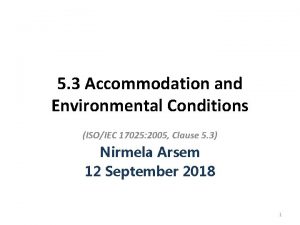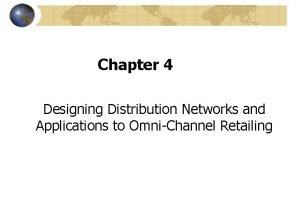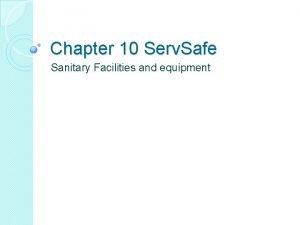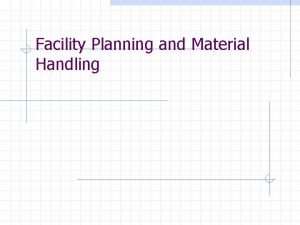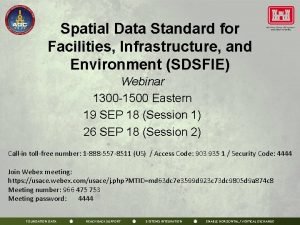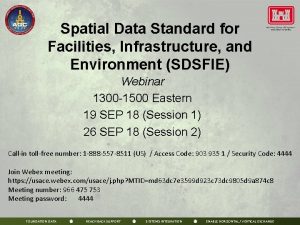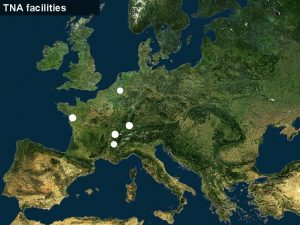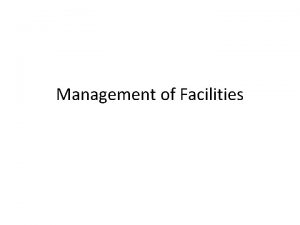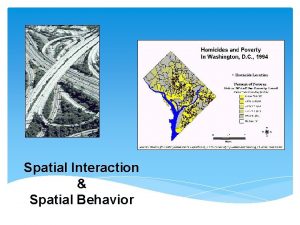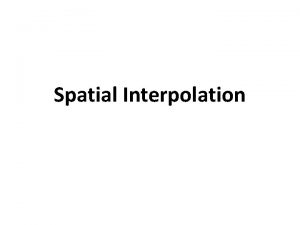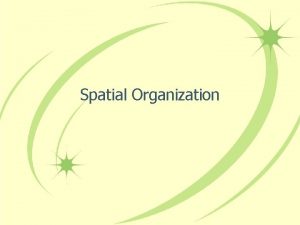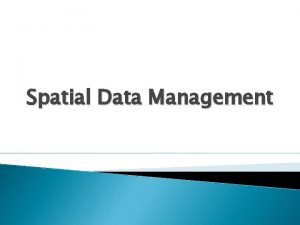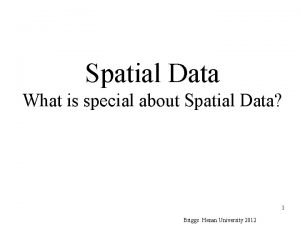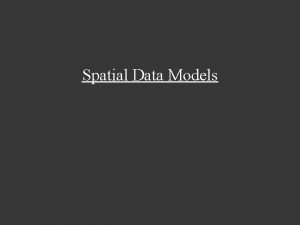Spatial Data Standard for Facilities Infrastructure and Environment





















































- Slides: 53

Spatial Data Standard for Facilities, Infrastructure, and Environment (SDSFIE) Overview Webinar 1300 -1500 Eastern 11 OCT 18 (Session 1) 24 OCT 18 (Session 2) Call-in toll-free number: 1 -888 -557 -8511 (US) / Access Code: 903 935 1 / Security Code: 4444 Webex: https: //usace. webex. com/usace/j. php? MTID=md 63 dc 7 e 3599 d 923 c 73 dc 9805 d 9 a 874 c 8 Meeting number: 966 475 753 Meeting password: 4444 DCS: https: //conference. apps. mil/webconf/SDSFIEVector. WG FOUNDATION DATA REACH BACK SUPPORT SYSTEMS INTEGRATION ENABLE HORIZONTAL / VERTICAL EXCHANGE

SDSFIE Overview Webinar • Agenda – What is SDSFIE? – Governance – Policies – Standards – Component (Service) Programs – SDSFIEOnline Demo • Notes: – Please mute phones unless asking questions! – You can also use “Chat” in Web. Ex or DCS to ask questions FOUNDATION DATA REACH BACK SUPPORT SYSTEMS INTEGRATION ENABLE HORIZONTAL / VERTICAL EXCHANGE 2

What is SDSFIE? • Family of geospatial data standards – Models – Specifications – Procedures/Workflows – Online tools • Purpose & Scope: For Do. D Installations and USACE Civil Works, make geospatial data and services visible, accessible, understandable, trusted, and interoperable across the Do. D Recreation Boundaries Transportation Environmental Airfields Planning Utilities Pavement Cultural Resources Natural Resources Buildings & Structures Military Range Training Reference, Elevation, & Survey FOUNDATION DATA REACH BACK SUPPORT SYSTEMS INTEGRATION ENABLE HORIZONTAL / VERTICAL EXCHANGE 3

SDSFIE Enables Interoperability Facilities Management Emergency Planning & Response Ranges & Training Areas Master Planning Cloud Integration with DOD Enterprise Systems Authoritative Data Source (IGI&S) Energy Management Environmental Management Force Protection and Security 13 FOUNDATION DATA REACH BACK SUPPORT SYSTEMS INTEGRATION ENABLE HORIZONTAL / VERTICAL EXCHANGE 4

What is SDSFIE? • Why standardize geospatial data? – Protect data investment – Ensure interoperability across programs and through time – Alignment with Do. D standards, policies, missions – Common and understandable visualization – Efficiencies with data collection, analysis, and tools – Auditability – You can’t collaborate if you don’t speak the same language • SDSFIE Is Mandated – DODI 8130. 01, Installation Geospatial Information and Services (9 Apr 2015; updated 25 Oct 2017) – EI&E Mission FOUNDATION DATA REACH BACK SUPPORT SYSTEMS INTEGRATION ENABLE HORIZONTAL / VERTICAL EXCHANGE 5

SDSFIE Program Goals 1. Advance and maintain SDSFIE in order to achieve interoperability for both data and systems, using accepted industry practices. 2. Promote implementation of SDSFIE Do. D-wide. 3. Align SDSFIE with functional business mission requirements and the Do. D Business Enterprise Architecture (BEA). 4. Maintain and sustain a coordinated SDSFIE program management process. 5. Educate, train, and support the implementation of SDSFIE within the user community. FOUNDATION DATA REACH BACK SUPPORT SYSTEMS INTEGRATION ENABLE HORIZONTAL / VERTICAL EXCHANGE 6

SDSFIE Principles • Mandatory enterprise spatial data standards for EI&E business missions (Do. D policy) • Governed by consensus of the Installation Geospatial Information and Services (IGI&S) Governance Group (IGG) • Responsive and built to support the official mission requirements and enterprise priorities of the Do. D business mission area, including civil works missions. • Shall not duplicate or overlap with external consensus standards for geospatial data – IGG continuously vet and endorse such standards for use across all Do. D installation, environment, and civil works missions • SDSFIE artifacts (e. g. schemas and code lists) reside in a publicly accessible repository • SDSFIE family of standards shall be vendor neutral, and shall reside in the public domain to the extent allowed by Do. D policy. FOUNDATION DATA REACH BACK SUPPORT SYSTEMS INTEGRATION ENABLE HORIZONTAL / VERTICAL EXCHANGE 7

SDSFIE Family of Standards • SDSFIE Vector: “Gold ” Logical Data Model and all Component HQ-level Adaptation LDMs. • SDSFIE Metadata: V 1. 0. 2 is Class-2 profile of ISO 19115 and ISO 19115 -2. V. 2 will be Class 2 profile of NSG Application Schema 8. 0 (includes ISO 19115 -1, 19115 -2, 19110, and 19157). • SDSFIE Raster: Preferred and recommended raster standards. Raster Standards Compendium - comprehensive summary of raster and related standards adopted, endorsed, recommended or referenced by the Department of Defense (Do. D). • SDSFIE Data Quality: Over-arching guidance for a tiered quality approach; includes data quality processes, measures, and metrics for vector, raster, and geospatial services. • SDSFIE Portrayal: Presentation of geospatial information; may include map portrayal, symbology, or related encoding specifications. • SDSFIE Services: Functionality provided through information technology-based interfaces (e. g. , web service interfaces). • SDSFIE Endorsed Standards: Consensus specifications, standards, models, and publications developed and managed by organizations other than DISDI, but which are vetted and endorsed and recommended for IGI&S use by DISDI. FOUNDATION DATA REACH BACK SUPPORT SYSTEMS INTEGRATION ENABLE HORIZONTAL / VERTICAL EXCHANGE 8

SDSFIE Family of Standards SDSDIE-Portrayal (P) States how each layer should be displayed on the map SDSDIE-Vector (V) Uniquely defines and names sets of geospatial features, e. g. , Building Footprints Installation Boundary Road Centerlines SDSDIE-Metadata (M) Metadata describes what is in the dataset; how it was produced; who did the work; when, & why SDSDIE-Quality (Q) Specifies how the dataset should be produced, maintained, and assessed and checked for quality SDSDIE-Raster (R) Provides guidance and best practices for acquiring and using raster data, e. g. , satellite and aerial imagery and elevation Fort Buchanan FOUNDATION DATA REACH BACK SUPPORT SYSTEMS INTEGRATION ENABLE HORIZONTAL / VERTICAL EXCHANGE 9

SDSFIE Family of Standards SDSDIE-Vector (V) – content standard for vector features • Uniquely defines and names sets of objects which can be represented by a point, line, or polygon, e. g. , • Installation Boundary - “Installation” • Road Centerlines - “Road. Centerline” • Building Footprints - “Building” • Specifies attributes about the set of features, e. g. , • Building. number. Of. Floors • Building. operational. Status • Building. rpuid SDSDIE-Metadata (M) – content standard for metadata • “Data about data” – defines a set of attributes that describe the database for one set of features, e. g. , • Originator – who created the data set? • Sources – what inputs were used to create the set of features? • Processing Steps – what was done to the inputs to create the set of features? • Currency – what is the time period of content? • POC - who can answer questions about it? SDSDIE-Quality (Q) – data quality standard • Specifies how the inputs for geospatial features and attributes should be collected, processed, and maintained, with QA/QC protocols and metrics SDSDIE-Raster (R) – raster data guidance • Provides use cases, best practices, and a compendium of standards for the acquisition and use of raster data SDSDIE-Portrayal (P) – data portrayal specification • Specifies the manner in which data layers are to be displayed, e. g. , line color, line size, line type • Specifies how those specifications are to be stored, maintained, and shared Fort Buchanan FOUNDATION DATA REACH BACK SUPPORT SYSTEMS INTEGRATION ENABLE HORIZONTAL / VERTICAL EXCHANGE 10

IGI&S Governance Do. D Joint Enterprise Standards Committee (JESC) Chief Management Officer, Defense Business Council (DBC) GEOINT STANDARDS WORKING GROUP (GWG) OASD(EI&E) GIO (DISDI) Note: The DISDI Program is an OSD initiative. The IGI&S Governance Group is a cross-service governance body. FOUNDATION DATA I&E Functional Business Governance Board (FBGB) The IGI&S Governance Group ACSIM, US Army (Army IGI&S) HQNAVFAC, US Navy (Geo. Readiness) Air Force Civil Engineer (Geo. Base) Headquarters, US Army Corps of Engineers MCICOM (GF-6), US Marine Corps (GEOFidelis) FSD / Federal Facilities Division, WHS REACH BACK SUPPORT SYSTEMS INTEGRATION ADVISORY Army National Guard Air National Guard National Geospatial. Intelligence Agency ENABLE HORIZONTAL / VERTICAL EXCHANGE 11

Governance • Under Secretary of Defense for Acquisition & Sustainment (USD(A&S)) • Assistant Secretary of Defense for Energy, Installations, and Environment (ASD(EI&E)) – Develops, manages, and publishes IGI&S standards – Established the Installation Geospatial Information and Services (IGI&S) governance group (the IGG) • Core members representing ASD(EI&E) (Chair); the Secretaries of the Military Departments; the Commandant of the Marine Corps; the Director, Washington Headquarters Services; the Commanding General, U. S. Army Corps of Engineers, and the Do. D Geospatial Intelligence (GEOINT) Manager (advisory). FOUNDATION DATA REACH BACK SUPPORT SYSTEMS INTEGRATION ENABLE HORIZONTAL / VERTICAL EXCHANGE 12

Governance • IGI&S Governance Group (IGG) – Chaired by ASD-IE&E (GIO) – Develops and recommends standards, and guidance – Govern change management process – Executed through working groups • • • Governance WG: Policies, Procedures Vector WG: Model changes and adaptations Metadata WG: Model updates and tools SDSFIEOnline WG: SDSFIEOnline and Workflow tools Quality WG: Metrics and processes Authoritative Data Source (ADS) WG FOUNDATION DATA REACH BACK SUPPORT SYSTEMS INTEGRATION ENABLE HORIZONTAL / VERTICAL EXCHANGE 13

SDSFIE Policy - DODI 8130. 01 Installation Geospatial Information and Services (IGI&S) 2. ASD(EI&E). a. Provides oversight and establishes uniform process for the use of IGI&S b. Develops, manages, and publishes IGI&S standards. 6. Do. D COMPONENT HEADS. The Do. D Component heads: a. Assign responsibilities and establish procedures within their Component to implement the data collection, guidelines, and procedures specified by this instruction. b. Ensure that all business systems, geospatial data assets, information, and IT services pertaining to installations and environment in the Active, Guard, and Reserve Components are in compliance with relevant standards, the interoperability guidance established by the ASD(EI&E), and this instruction. 7. SECRETARIES OF THE MILITARY DEPARTMENTS AND DIRECTOR, WHS. In addition to the responsibilities in section 6 of this enclosure, the Secretaries of the Military Departments and the Director, WHS: a. Designate IGI&S elements within their respective organizations to coordinate IGI&S capabilities and facilitate integration of IGI&S activities and organizational functions across the Do. D business enterprise. 8. SECRETARY OF THE ARMY. In addition to the responsibilities in sections 6 and 7 of this enclosure, the Secretary of the Army: a. Provides technical development, change management, general support, and implementation support for IGI&S standards, which will be a function supporting the IGG. b. Ensures that the IGI&S requirements of the United States Army Corps of Engineers civil works program are met, and that these requirements are fully represented in the IGG. FOUNDATION DATA REACH BACK SUPPORT SYSTEMS INTEGRATION ENABLE HORIZONTAL / VERTICAL EXCHANGE 14

Implementing Do. DI 8130. 01, Installation Geospatial Information and Services (IGI&S) • Key actions triggered by Do. DI 8130. 01 – Army officially tasked to manage the technical development of SDSFIE (tasked to USACE Army Geospatial Center (AGC)) – IGI&S Governance Group (IGG) established and empowered to: • Develop IGI&S standards (mandated by ASD(EI&E)) • Establish guidelines for portfolio management of IGI&S investments • Recommend CIP content and related processes to ASD(EI&E) – Components must implement an IGI&S authoritative data source (ADS) for each installation – Common Installation Picture (CIP): annual data call – DISDI PM becomes the EI&E Geospatial Information Officer (GIO) FOUNDATION DATA REACH BACK SUPPORT SYSTEMS INTEGRATION ENABLE HORIZONTAL / VERTICAL EXCHANGE 15

SDSFIE Policy Governance Plan • Roles, responsibilities, governance objectives, & processes that guide development and use of SDSFIE. • Applies to Do. D EI&E, USACE Civil Works, any other Do. D organization mandated to use SDSFIE as specified in the Do. D IT Standards Registry (DISR) • Defines: – The 7 parts of the SDSFIE family of standards & guiding principles for each • Component Implementation Plans must be developed/reviewed by IGG (where applicable) – – SDSFIE IGG Governance process SDSFIEOnline website requirements process Versioning process for SDSFIE models Component Adaptation development and submittal process • Mandated steps, documentation, and review/approval process for developing adaptations to SDSFIE Gold Vector data models. – SDSFIE Change Management Process (Change Request) FOUNDATION DATA REACH BACK SUPPORT SYSTEMS INTEGRATION ENABLE HORIZONTAL / VERTICAL EXCHANGE 16

SDSFIE Policy SDSFIE Vector Implementation Guidance (SVIG) • Mandates use with mapping requirements for – – Energy EI&E domain Test and training range management USACE Civil Works • Rules that apply to Components as they prepare for and execute the implementation of an SDSFIEV version • Defines vector data model elements • Guidelines for preparing and implementing a headquarters Adaptation – Rules governing the creation of both headquarters and subordinate Adaptations of SDSFIE-V in a manner that maintains interoperability across all SDSFIE Components – Agreed upon and used by all Components • Mandates Component Vector Implementation Plan • Mandates Component Vector Data Migration Plan (for new versions) FOUNDATION DATA REACH BACK SUPPORT SYSTEMS INTEGRATION ENABLE HORIZONTAL / VERTICAL EXCHANGE 17

SDSFIE Policy Vector Model 4. 0 Mandate • Memo 9 Feb 2017: Mandate to Implement the SDSFIE Vector Data Model version 4. 0 – Component implementation plans by 31 OCT 17 • Plan and schedule • Change & Governance • Migration Plan – HQ Adaptations by 31 Oct 19 – Migration by 31 Dec 2020 FOUNDATION DATA REACH BACK SUPPORT SYSTEMS INTEGRATION ENABLE HORIZONTAL / VERTICAL EXCHANGE 18

SDSFIE Policy SDSFIE Metadata Implementation Guidance • Implements Do. DI 8320. 02 (for IGI&S per Do. DI 8130. 01), and supports goals of EO 12906, OMB Circular A-16, and OMB Memorandum M-13 -13 – Do. D IT Resources discoverable, understandable, and trusted. – Registered in Do. D Data Services Environment (DSE) • Mandates Do. D SDSFIE-M records be created for each applicable SDSFIE-compliant data set or service. – Note: Component mandate memorandum is anticipated in early CY 2019 • • • Applies to vector, raster, and services Model versioning process Component Implementation Plans for mandated versions Accessibility rules; discoverability support Legal and security restraints Metadata tools (SDSFEI-M Metadata Style for Esri Arc. GIS) FOUNDATION DATA REACH BACK SUPPORT SYSTEMS INTEGRATION ENABLE HORIZONTAL / VERTICAL EXCHANGE 19

SDSFIE Policy SDSFIE Raster • Raster and related standards adopted, endorsed, recommended or referenced by the Department of Defense (Do. D) via the National System for Geospatial Intelligence (NSG) • Guidance for application of raster standards and data resolutions for IGI&S community, including standards defined by the US government, international standards and other third party organizations • Assist IGI&S community in identifying the most applicable and useful raster standards for a range of common raster data use cases • Compendium: Comprehensive listing of a wide range of imagery and raster standards which have applicability to one or more organizations or missions within the community. FOUNDATION DATA REACH BACK SUPPORT SYSTEMS INTEGRATION ENABLE HORIZONTAL / VERTICAL EXCHANGE 20

SDSFIE Policy SDSFIE Quality • Over-arching guidance for how Do. D will implement a tiered approach to quality, including data quality processes, measures, and metrics for vector, raster, and geospatial services developed and used by the IGI&S community • Defines a framework for IGI&S data quality, with enterprise-level and Component-level elements. • Processes needed to ensure quality data management or data collection and maintenance at a Department-wide level. • Identifies the important elements that should be covered in IGI&S Program level quality management plans • Formal process for defining measures to assess data quality and completeness, and the reporting of metrics associated with these data quality measures using the SDSFIE Metadata (SDSFIE-M) standard • Also includes certain specific data quality processes, measures, and metrics which apply individually to IGI&S vector and raster data, or services FOUNDATION DATA REACH BACK SUPPORT SYSTEMS INTEGRATION ENABLE HORIZONTAL / VERTICAL EXCHANGE 21

SDSFIE-V, -Q, and -M Implementation 10 /2 25 -Jun-2018 3 02 23 10 20 4/ IGG 5 -Year Plan /2 2 02 22 / 10 20 4/ IGI&S Governance Group (IGG) 1 2 20 4/ 1 / 10 A = Adaptation Submission B = Develop Data Migration Plan C = Data Migration 0 2 20 4/ 0 / 10 9 1 20 4/ 9 / 10 1 20 nts) 8 1 20 4/ A 8 / 10 17 20 : USN COMPONENTS E: SAC C te C B B B EL DEV 19 Y --F F: USA 8 -1 Y --F DISDI DCS CIP: Ps M OP Q C: s RBJ and ’s DCS PON COM : USA USM CIP ENT 0 -2 Y --F 21 Y --F ER D TH LL O NT A mple a Co --23 Y F -- leme lity E t a etad 22 Y --F T M CIP F C C C B U FOUNDATION DATA ua d (Q CS’s PME ELO DEV SDSFIE-V: 4. 0 Fully Implemented (goal) [Jan-2021] ASD(EI&E): SDSFIE-Q Mandated; SDSFIE-M Mandated [Sep-2019] SDSFIE-M 2. 0: Emerging [Dec-2018] REACH BACK SUPPORT SYSTEMS INTEGRATION ENABLE HORIZONTAL / VERTICAL EXCHANGE 22

SDSFIE-V “Models” • In SDSFIE-Vector, or “SDSFIE-V”, a “Model” consists of an organized set of “elements”: – A set of Entities (Feature Types and/or nonspatial Object Tables) SDSFIE-V 4. 0 Gold Army 4. 0 • with Attributes, or characteristics, for each feature • Attributes may be constrained by Enumerations – Enumerations (“picklists”) have a set of Enumerants Air Force 4. 0 … • and, potentially, participate in Associations • In each Version of SDSFIE-V (e. g. , 3. 1 or 4. 0), there is a Gold model that is the root of all other models • Each Service adapts the Gold model to create their own Headquarters Adaptation model • Services can allow lower echelons to develop their own Sub-Adaptation • All adaptations must adhere to SDSFIE-V Implementation Guidance (SVIG) FOUNDATION DATA REACH BACK SUPPORT SYSTEMS INTEGRATION Navy Data Model 4. 0 GEOFidelis 4. 0 USACE HQ 4. 0 … ENABLE HORIZONTAL / VERTICAL EXCHANGE 23

SDSFIE-V Adaptation Approach • “SDSFIE Adaptation” defined: A formalized alteration of a model which results in another model tailored to the particular business requirements of an implementing organization. An Adaptation consists of a specific Profile and/or all the Extensions that are required to meet specific business requirements. • SDSFIE Adaptation consists of three primary steps: – “profiling” – removing non-mandatory elements that the implementing organization does not require • Any entity other than those used in Installation CIP • Any non-foundational attribute – “extending” – adding required elements not found in the parent model (e. g. , needed by USACE but not in Gold) – “changing” – altering model, without affecting interoperability FOUNDATION DATA REACH BACK SUPPORT SYSTEMS INTEGRATION ENABLE HORIZONTAL / VERTICAL EXCHANGE 24

Vector Data Migration Overview SDSFIE-V Gold 3. 1 SDSFIE-V Gold 4. 0 As-Is (Source) To-Be (Target) Cemetery (split) Cemetery. Or. Burial. Site Underground. Storage. Tank Entity-level crosswalk Belowground. Storage. Tank Pollution. Area Fish. Hatchery (not in Target) FOUNDATION DATA REACH BACK SUPPORT Burial. Site (split) Storage. Tank (merged) Contamination. Site (changed) + Solid. Waste. Landfill (added; not in Source) SYSTEMS INTEGRATION ENABLE HORIZONTAL / VERTICAL EXCHANGE 25

SDSFIE Standards Metadata (SDSFIE-M) • Conceptual Schema • Defines metadata content to be collected for vector and raster data, and services SDSFIE-M used to define an Esri “Metadata Style”, which specifies IGI&Spertinent information about a data set Esri Arc. Catalog “Metadata Style” • Implements the conceptual schema for in editor GUI, and provides for interchange Esri Arc. Catalog Esri “Metadata Style” for SDSFIE-M provides the correct structure to import and export metadata for an SDSFIE-V dataset with the required information and in the right format FOUNDATION DATA REACH BACK SUPPORT SYSTEMS INTEGRATION Metadata Document e. g. SDSFIE-V Storage. Tank ENABLE HORIZONTAL / VERTICAL EXCHANGE 26

SDSFIE Standards Quality (SDSFIE-Q) • Framework for Quality Measurement • Defines general quality metrics for vector and raster data, and services Data Content Specification (DCS) • Implements the SDSFIE-Q framework for a particular dataset • Defines a specific set of metrics for SDSFIE-V data sets; first for the 30 “CIP Layers” SDSFIE-Q provides a framework and guidance for data quality metrics DCS provides specific metrics for an SDSFIE-V data set to be generated through an Esri “Data Review Batch Job” (DRBJ) FOUNDATION DATA REACH BACK SUPPORT Military. Range SYSTEMS INTEGRATION DRBJ provides inputs to data quality section of metadata document, in format defined by SDSFIE-M Metadata Document e. g. SDSFIE-V Military. Range ENABLE HORIZONTAL / VERTICAL EXCHANGE 27

SDSFIE-V 3. 1 Layer Name SDSFIE-V 4. 0 Layer Name Geometry Access. Control P/L Barricade Air. Accident. Zone Air. Accident. Potential. Zone A Bridge A/L Building A Docks. And. Wharfs Dock. Or. Wharf A Environmental. Remediation. Site Environmental. Restoration. Site A Env. Restoration. Site. Mra A Env. Restoration. Site. Mrs A Fence L Golf. Course A Historic. District A Impact. Area A Installation A Land. Parcel A Land. Use A Military. Range A Military. Training. Location A Mil. Quantity. Distance Combined. Arc Esqd. Arc. Composite A Noise. Zone A Outgrant A Pavement. Branch* Pavement. Branch A Pavement. Section* Pavement. Section A Pavement. Section. Airfiled A Pavement. Section. Roadway A Pavement. Section. Sidewalk A Rail. Segment** Rail. Segment L Rail. Track** Rail. Track L Recreation. Area Recreation. Boundary A Road. Centerline (not in Gold)*** Road. Centerline L Road. Path*** Road. Path L Road. Seg*** Road. Segment L A/P Site Tower P Vehicle. Parking. Area A Wetland A FOUNDATION DATA REACH BACK SUPPORT Common Installation Picture (CIP) • Provide a readily available, standardized map background to serve as the basis for planning and execution of EI&E missions. • Includes a requirement for an authoritative geospatial feature for all Do. D real property sites as well as a select group of real property asset types. • Do. DI 4165. 14, Real Property Inventory (RPI) and Forecasting, requires that a geospatial feature be created for each real property asset. SYSTEMS INTEGRATION ENABLE HORIZONTAL / VERTICAL EXCHANGE 28

SDSFIE Army Implementation • US Army Installation Geospatial Information & Services (IGI&S) Program • HQDA, Office of the Army Chief of Staff for Installation Management (OACSIM), DAIM-ODR – Vince Nicchitta, IGI&S Program Manager • 571 -256 -8160; Vincent. H. Nicchitta 2. civ@mail. mil – David Hulka, IGI&S Deputy Program Manager • 571 -256 -8159, David. A. Hulka. civ@mail. mil – Martina Harmon, IGI&S Communications Lead / SDSFIE Coordinator • 571 -256 -8158, Martina. S. Harmon. ctr@mail. mil

SDSFIE Army Implementation • Regulations & Policies – Army Regulation 115 -11; Army Geographic Information and Services – Army Regulation 115 -13; Army Installation Geographic Information and Services – SDSFIE-V 4. 0 Army Adaptation Migration Memo (Pending Signature) • Current model: SDSFIE 3. 1. 6 Army Adaptation • New model: SDSFIE-V 4. 0. 2 Army Adaptation • Guidance Documentation – – – Vector Implementation Plan Vector Migration Plan Vector Pre-Migration Guidance Vector Post Migration Guidance Quality Assurance Plans

Army Vector Mandate • Pending DACSIM Signature – Anticipated early October 2019. • Directs start of migration for all Army IE&E geospatial data across Active, Guard, and Reserve sites. • References development and migration milestones outlined in ASD(EI&E) 9 FEB 17 memo.

Army Implementation Plan • Outlines document purpose and provides SDSFIE overview • Provides driver references and defines key terms and common acronyms • Defines implementation roles and responsibilities throughout Army IGI&S • Details exact adaptation process for each level of Army IGI&S – (HQ, Army Organizations, & Installations) • Outlines all physical implementation rules as mandated by DISDI & OACSIM • Provides brief overview of way forward through migration and change management

Army Migration Plan • Provides background and lessons learned from previous migration. • Clearly states migration objectives. • Briefly outlines Pre-Migration Planning, Data Migration Workflow, and Post-Migration Actions. • Provides high-level migration timeline and link to installation specific timeline.

Army Migration Guidance Pre-Migration, Post Migration Pre-Migration Guidance • Establishes guidance for data handling and processing prior to migrating Army installation data to the SDSFIE-V 4. 0 Army Adaptation. • Step-by-step guide to Army-specific pre-migration tools. • Step-by-step guide to SDSFIE Online provided pre-migration tools. Migration Guidance • Establishes the OACSIM IGI&S approved workflow for migrating to the SDSFIE-V 4. 0 Army Adaptation. • Step-by-step guide to using the SDSFIE Online Migration Workflow to migrate Army data. • Includes diagrams and detailed images to explain troublesome portions of online too. • Includes FAQ and Troubleshooting section. Post Migration Guidance • Basic steps currently included in Migration Guidance. • Separate guidance will be published likely after the first migration group to address all post migration hurtles.

Army Quality Assurance Plans Objective: QAPs are GIS feature-level documents that describe geospatial data and metadata content specifications, validation methodology, acceptable data sources, internal handling controls and how the SDSFIE Army Adaptation feature type is aligned with HQIIS. Details e t a D S V E I F S 0. 4 d p U • Current QAPs v 3. 3 are written for the SDSFIE v 3. 1 Army Adaptation • Published 10 -Jan-2017, mid-year release for minor changes • Reviewed and updated annually by Proponents • Prepares for OACSIM Army business system alignment (HQIIS) • Proponency (and # published) at v 3. 3 - DAIM-OD (Operations Directorate) - 119 - DAIM-IS (Installation Services) - 80 - DAMO-TRS (Training Simulations) - 32 - DAMO-AV (Aviation) - 1 - USACE (Corps of Engineers) – 9 • QAPs v 4. 0 to be published with roll-out of SDSFIE 4. 0 Army Adaptation

Air Force SDSFIE Implementation • Program Name: Air Force Geo. Base • Program Management – Air Force Civil Engineering Center – Geospatial Information Office (AFCEC GIO) • Email: AFCEC. GIO. Workflow@us. af. mil • Website: https: //maps. af. mil (NIPR) and https: //maps. acc. af. smil. mil (SIPR) • Implementing Policies/Guidance – Air Force Instruction 32 -10112 (Installation Geospatial Information and Services) • Currently utilizing SDSFIE-Vector 3. 1 • Developing Air Force adaptation of SDSFIE family of standards – Development complete Dec 2019 – Migration complete Oct 2020 FOUNDATION DATA REACH BACK SUPPORT SYSTEMS INTEGRATION ENABLE HORIZONTAL / VERTICAL EXCHANGE 36

Navy SDSFIE Implementation • Program Name: Navy Geo. Readiness Enterprise IGI&S Program • Program Management – Naval Facilities Engineering Command (NAVFAC) HQ, AM Asset Utilization (AM 4) • Email: darrell. r. robertson@navy. mil • Website: http: //hub. navfac. navy. mil/go/Geo. Readiness • Implementing Policies/Guidance – Do. DI 8130. 01: Installation Geospatial Information and Services (IGI&S) – Navy Geo. Readiness IGI&S Data Collection Guidance (DCG) • Currently utilizing SDSFIE-Vector 3. 03 • Developing Navy adaptation of SDSFIE family of standards – Development complete December 2018 – Migration complete September 2019 FOUNDATION DATA REACH BACK SUPPORT SYSTEMS INTEGRATION ENABLE HORIZONTAL / VERTICAL EXCHANGE 37

USMC IGI&S Program GEOFidelis Ø GEOFidelis is the USMC Installation Geospatial Information and Services (IGI&S) program for Installation and Environmental geospatial products and services. • Ø The GEOFidelis Program coordinates with Functional Data Set Leads and Subject Matter Experts (SMEs) at Marine Corps Installation Command (MCICOM) to ensure USMC enterprise-wide business requirements and the geospatial features to support those requirements are included in our standardized environment. • Ø GEOFidelis was established to support the people, policies, and information resources necessary to acquire, manage, and sustain installation & environmental geospatial assets (imagery and data) in support of the Marine Corps' mission. This ensures the resulting standards will: - Integrate with business systems and provide visualization and analysis of USMC installation business data. - Focus USMC geospatial data management to collect geospatial features best suited for Functional Data Set leads and SME use. - Eliminate redundant business data collection by linking to authoritative business systems. - Meet an acceptable level of data quality to effectively support the mission. POC: • • GEOFidelis GIO: Justin Goering Program Analyst: Tim Dougherty Program Support: PG Katsourakis Program Support: Jacqueline Nova 38

GEOFidelis Policies and Web GIS Interface Ø Policies and Guides • MCO 11000. 25 A: Installation Geospatial Information and Services – July 3 rd 2013 • GEOFidelis Data Management Guide • GEOFidelis Data Layer Specifications (DLSs)—On Hold • GEOFidelis SDSFIE-Vector 4. 0 Implementation Plan • GEOFidelis Metadata Guide—Coming Soon Ø GEOFidelis Portal • CAC enabled Portal for Arc. GIS implementation • Contains Installation Geospatial Information & Services (IGI&S) cartographic products and data disseminated through a userfriendly, searchable repository for geospatial applications and shared maps. • https: //www. geofidelis. usmc. mil/portalprod/home or through MCICOM Portal (https: //mcicomportal. usmc. mil)

Component Implementation: Headquarters Adaptation Development Strategy Ø Currently using the GEOFidelis Data Model (GDM) 3. 0. 0. 2 Model • Ø The GEOFidelis program consolidated the subordinate adaptations into an intermediary version of GDM 3. 0. 0. 1 for internal USMC release during FY 18 -Q 1. - The core development of GDM 3. 0. 0. 2 is a standardization of Central Repository (CR) and Critical Infrastructure layers with awareness of SDSFIE-V 4. 0 migration proximately and standardizes features internal to the USMC IGI&S community without elevating the new data model to the SDSFIE Change Management Process. GDM 4. 0 will not allow for subordinate adaptations from USMC Regional Commands and Installations. • • • This policy change from GDM 3. 0. 0. 2, in which Regions and Installations could establish subordinate adaptations, requires an analytical consolidation of adaptation differences from the USMC HQ Adaptation GDM 4. 0 development began from GDM 3. 0. 0. 2 which is divided into Standardized layers and Non-Standardized Layers. - The standardized layers are comprised of the feature types that were consolidated in the GDM 3. 0. 0. 2 effort with future migration to GDM 4. 0 acknowledged. - The non-standardized layers have not been consolidated from subordinate adaptations. GDM 4. 0 is currently in draft development and is about to undergo MCICOM wide SME/Stakeholder view - [Complete] First Step: Revise all GDM 3. 0. 0. 2 non-standardized layers through the same consolidation process the standardized layers went through in the development of GDM 3. 0. 0. 2. - [Complete] Second Step: Develop SDSFIE 4. 0 Crosswalks and transformation for all consolidated layers - [In-Progress] Third Step: Establish Feature Dataset working groups with Installation SMEs to validate GDM 4. 0 Model - Fourth Step: Finalization of GDM 4. 0 for IGG Review and approval

GDM 4. 0 Data Migration Plan Ø GEOFidelis Regional Commands and Installations will be required to migrate data from GDM 3. 0. 0. 2 to GDM 4. 0 throughout FY 20. Ø The IGG approved USMC Headquarters Adaptation of GDM 4. 0 will be used to create the top tier of the enterprise geodatabase stored at the USMC Data Center-Facility Service Branch (FSB). Following the creation of GDM 4. 0 installation geodatabase creation, based on the Headquarters Adaptation, installations will be provided an environment to migrate their data into their respective enterprise geodatabase instances.

USACE SDSFIE Implementation • Program Management – HQ USACE Geospatial Community of Practice (COP) Lead • Nancy Blyler, Chair USACE Geospatial Data Standards PDT & COP Lead – Army Geospatial Center • Paul Dubois; USACE Civil Works implementation support; • IGG Execution Support • Implementing Policies/Guidance – Army Regulations 115 -11 and 115 -13 – Engineering Regulation 1110 -1 -8156; Policies, Guidance, and Requirements for Geospatial Data and Systems) • HQ USACE 3. 1 implemented • HQ USACE 4. 0. 1 approved • Migrating to HQ USACE 4. 0. 2 (after Army Adaptation 4. 0. 2 is completed) – Vector Implementation Plan – Migration Plan: Estimated January 2020 completion FOUNDATION DATA REACH BACK SUPPORT SYSTEMS INTEGRATION ENABLE HORIZONTAL / VERTICAL EXCHANGE 42

SDSFIE Online – Homepage https: //www. sdsfieonline. org Consent Banner – An initial pop-up to give consent After consenting, you have access to the SDSFIE Online Homepage – Provides a brief overview of SDSFIE, with links to the all parts of SDSFIE Online, with 4 main sections Menu Strip section – Access to all tools and pages Welcome section – What’s New? section – Highlights new developments or updated tools / documents A brief explanation of SDSFIE along with a “Learn More” link that will direct you to a page that explains the SDSFIE Family of Standards. FOUNDATION DATA Stakeholders section – provides links to each Component page REACH BACK SUPPORT SYSTEMS INTEGRATION ENABLE HORIZONTAL / VERTICAL EXCHANGE 43

SDSFIE Online – The Menu Strip: Home – will always take you to the Welcome (Home) page • Top of almost all SDSFIE Online pages (not Tools) • Versatile • Hover/click accesses different SDSFIE Online topics and functions SDSFIE Online – provides links to general information and how to get started FOUNDATION DATA Standards – provides details on each of the SDSFIE Standards Models & Workflows – provides links to each of the SDSFIE Tools, and the means to interact with the models Components - provides links to each component page (identical to the links on the Home page) Support – provides links to a FAQ page, SDSFIE User Guides and additional training REACH BACK SUPPORT SYSTEMS INTEGRATION ENABLE HORIZONTAL / VERTICAL EXCHANGE 44

SDSFIE Online – “SDSFIE Online” What is SDSFIE Online? – Provides an overview of SDSFIE Online and the SDSFIE family of standards. Register User – first, create User Account Getting Started – Three step process: Log In As User – must log in to obtain access to models and tools Step 1) Register Step 2) Learn More Step 3) Get to Work • Takes 24 -48 hrs, normally less • Standard password reset and username recovery functions Learn More – See “Support” menu item. Website Changelog FOUNDATION DATA • Specify a Sponsor or Manager REACH BACK SUPPORT SYSTEMS INTEGRATION ENABLE HORIZONTAL / VERTICAL EXCHANGE 45

SDSFIE Online – “Standards” FOUNDATION DATA REACH BACK SUPPORT SYSTEMS INTEGRATION ENABLE HORIZONTAL / VERTICAL EXCHANGE 46

SDSFIE Online – “Models & Workflows” Browse Generate – allows examination of a single model at a time and/or publishes a physical or logical data representation of that model Data Dictionary – provides multi-faceted search interface and reports across all logical data models, with saved search function Migration – supports moving data repositories to new (target) models, with capabilities for managing and registering custom data and sub-adaptations Model Builder - provides for creation and editing of logical data models, with options for interactive GUI or workbook upload for large/complex models Validate – facilitates comparison between any two models, including source to parent mode, with workbook output; shows adherence to SDSFIE rules FOUNDATION DATA REACH BACK SUPPORT SYSTEMS INTEGRATION ENABLE HORIZONTAL / VERTICAL EXCHANGE 47

SDSFIE Online – “Components” US Army Page To be Updated Soon! • US Army HQ 4. 0. 2 – model details • Implementation Plan • Migration Guidance and Support FOUNDATION DATA REACH BACK SUPPORT SYSTEMS INTEGRATION ENABLE HORIZONTAL / VERTICAL EXCHANGE 48

SDSFIE Online – “Support” SDSFIE FAQ – commonly asked questions and general information about SDSFIE and the website; accessible from the “Get Help” link at the bottom of any page User Guides and Training Videos – 4 Tool/Workflow downloadable user guides and 26 training videos (watch through You. Tube, or download) Direct Contact “Help Desk” – response within 24 hrs (8: 00 AM-4: 30 PM EST Mon-Fri) • Webform email submission • Email: support@sdsfieonline. org • Phone: (571) 403 -0238 FOUNDATION DATA REACH BACK SUPPORT SYSTEMS INTEGRATION ENABLE HORIZONTAL / VERTICAL EXCHANGE 49

Support – Details, and More Resources • SDSFIE Online – User Guides (5 “how-to” format) – FAQ – Training (26 videos) • Background (4) • Data Dictionary (2) • Browse/Generate (5) • Model Builder (8) • Validation (2) • Migration (5) • AGC – Online; Guidance; Standards; Requirements; Modeling • Leidos/Image Matters Support Team – Tech Support (via SDSFIE “Help Desk”) – Training (webinars) – Migration support (multiple 3 -4 day events) FOUNDATION DATA REACH BACK SUPPORT SYSTEMS INTEGRATION ENABLE HORIZONTAL / VERTICAL EXCHANGE 50

DISDI Portal http: //disdiportal. osd. mil/ FOUNDATION DATA REACH BACK SUPPORT SYSTEMS INTEGRATION ENABLE HORIZONTAL / VERTICAL EXCHANGE 51

Summary of Required Actions • General Management – Implement SDSFIE standards across the entire IGI&S and USACE CW geospatial enterprise • Vector: – Implement SDSFIE Gold 4. 0 – Component Vector Implementation Plan (31 OCT 17) – Component HQ 4. 0. X Adaptation (31 OCT 19) – Component HQ 4. 0. X Migration Plan (with adaptation) – Complete migration to HQ Adaptation (31 DEC 20) • Metadata: – Implement SDSFIE-M 2. 0 – Mandate anticipated JAN 2019 – Component Metadata Implementation Plans (TBD) • Quality: – Mandate anticipated SEP 2019 – Component Quality Implementation Plans (TBD) • Common Installation Picture (CIP) Data Call (Annual) FOUNDATION DATA REACH BACK SUPPORT SYSTEMS INTEGRATION ENABLE HORIZONTAL / VERTICAL EXCHANGE 52

QUESTIONS? ? Paul Dubois: 703 -428 -6742 paul. c. dubois@usace. army. mil Dr. Jeff Ehman: 812 -325 -7937 jeffe@imagemattersllc. com FOUNDATION DATA REACH BACK SUPPORT SYSTEMS INTEGRATION ENABLE HORIZONTAL / VERTICAL EXCHANGE 53
 Spatial data vs non spatial data
Spatial data vs non spatial data Swiss vbs
Swiss vbs National spatial data infrastructure
National spatial data infrastructure Spatial data infrastructure components
Spatial data infrastructure components Components of gis
Components of gis Spatial data and attribute data
Spatial data and attribute data Unstructured cabling
Unstructured cabling Environment of business finance
Environment of business finance In keeping equipment and facilities safe and sanitary
In keeping equipment and facilities safe and sanitary Spatial data quality
Spatial data quality Spatial data mining applications
Spatial data mining applications Spatial data acquisition
Spatial data acquisition Components of gis
Components of gis Spatial data acquisition
Spatial data acquisition Big spatial data
Big spatial data Spatial data input
Spatial data input Spatial big data platform
Spatial big data platform Gis data structure types
Gis data structure types Spatial data transformation
Spatial data transformation Big data spatial
Big data spatial R and gis
R and gis What is spatial data?
What is spatial data? Oregon spatial data library
Oregon spatial data library Standard error of mean
Standard error of mean Home language
Home language Standard costing features
Standard costing features Public area cleaning equipment
Public area cleaning equipment Purchasing receiving storing and issuing
Purchasing receiving storing and issuing Amenities and facilities difference
Amenities and facilities difference Iso 17025 environmental conditions
Iso 17025 environmental conditions Desired response time and number of facilities
Desired response time and number of facilities Sanitary facilities and equipment
Sanitary facilities and equipment Material handling and facilities planning
Material handling and facilities planning Providing support services facilities and other amenities
Providing support services facilities and other amenities Translators and facilities of languages
Translators and facilities of languages Safe facilities and pest management
Safe facilities and pest management Kontinuitetshantering i praktiken
Kontinuitetshantering i praktiken Typiska novell drag
Typiska novell drag Nationell inriktning för artificiell intelligens
Nationell inriktning för artificiell intelligens Returpilarna
Returpilarna Varför kallas perioden 1918-1939 för mellankrigstiden
Varför kallas perioden 1918-1939 för mellankrigstiden En lathund för arbete med kontinuitetshantering
En lathund för arbete med kontinuitetshantering Särskild löneskatt för pensionskostnader
Särskild löneskatt för pensionskostnader Personlig tidbok
Personlig tidbok Sura för anatom
Sura för anatom Förklara densitet för barn
Förklara densitet för barn Datorkunskap för nybörjare
Datorkunskap för nybörjare Tack för att ni lyssnade bild
Tack för att ni lyssnade bild Mall för debattartikel
Mall för debattartikel Magnetsjukhus
Magnetsjukhus Nyckelkompetenser för livslångt lärande
Nyckelkompetenser för livslångt lärande Påbyggnader för flakfordon
Påbyggnader för flakfordon Arkimedes princip formel
Arkimedes princip formel Publik sektor
Publik sektor

